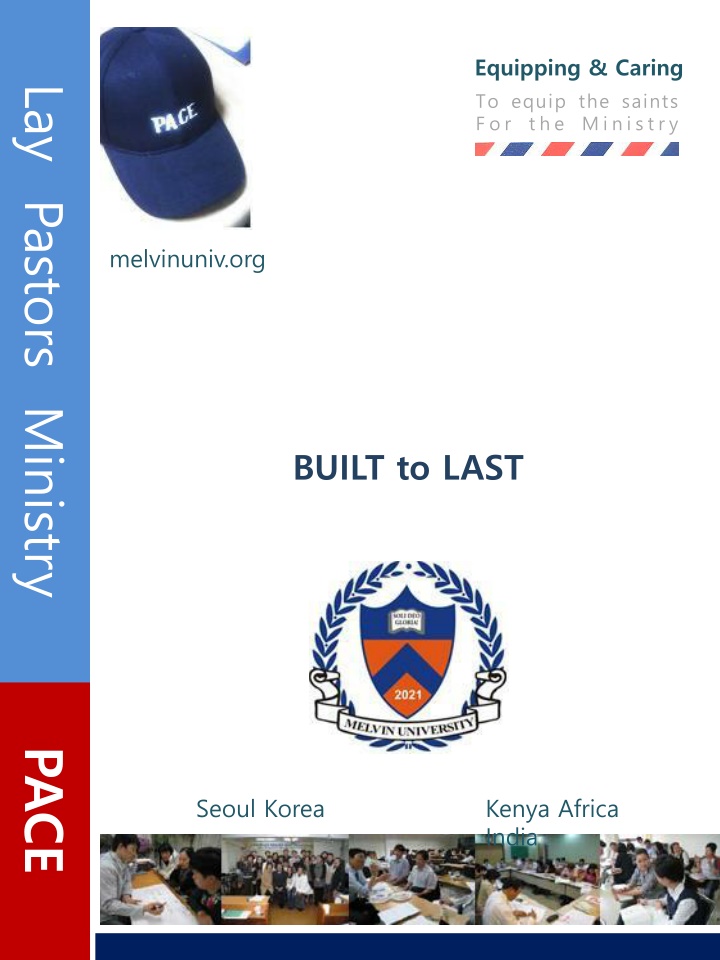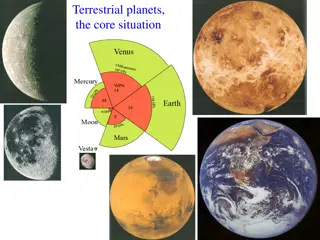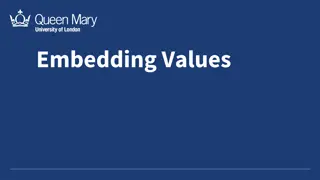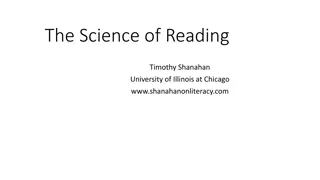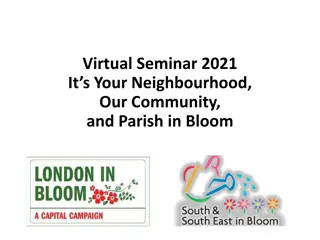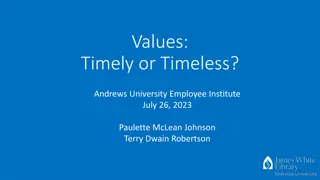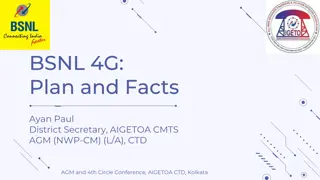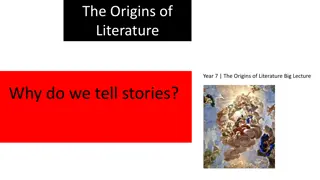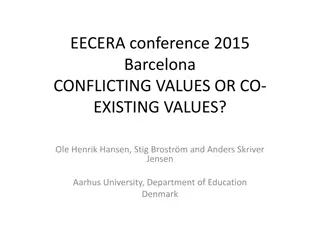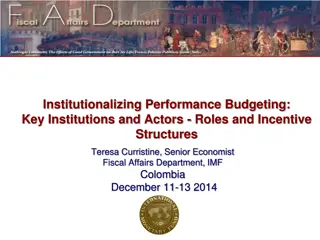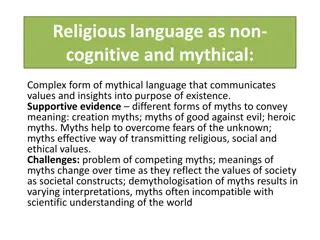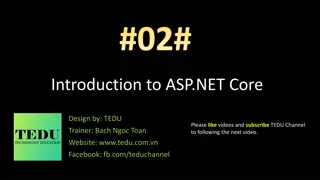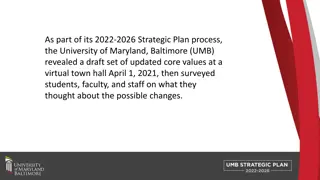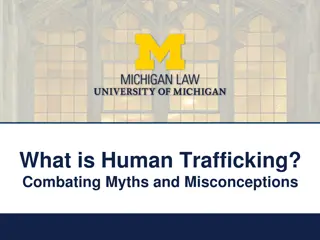Building Visionary Organizations: Dispelling Myths and Embracing Core Values
Dispelling common myths about starting and leading visionary organizations, focusing on the importance of core values and building organizations that outlast individual leaders. Emphasizing the distinction between "time telling" and "clock building" as a key strategy for long-term success.
Download Presentation

Please find below an Image/Link to download the presentation.
The content on the website is provided AS IS for your information and personal use only. It may not be sold, licensed, or shared on other websites without obtaining consent from the author.If you encounter any issues during the download, it is possible that the publisher has removed the file from their server.
You are allowed to download the files provided on this website for personal or commercial use, subject to the condition that they are used lawfully. All files are the property of their respective owners.
The content on the website is provided AS IS for your information and personal use only. It may not be sold, licensed, or shared on other websites without obtaining consent from the author.
E N D
Presentation Transcript
Equipping & Caring To equip the saints F o r t h e Lay Pastors Ministry PACE M i n i s t r y melvinuniv.org BUILT to LAST Seoul Korea Kenya Africa India 1
Some Shattered Myths Myth 1: It takes a great idea to start a great ministry/organization. Reality : Starting a organization with a "great idea" might be a bad idea. Few of the visionary organization began life with a great idea. Like the parable of the tortoise and the hare, visionary organizations often get off a slow start, but win the long race. Myth 2: Visionary organizations require great and charismatic visionary leaders. Reality : A charismatic visionary leader is absolutely not required for a visionary organization and, in fact, can be detrimental to a organization's long-term prospects. Myth 3: Highly successful organizations make their best moves by brilliant and complex strategic planning. Reality : Visionary organizations make some of their best moves by experimentation, trial and error, opportunism - quite literally - accident. Myth 4: Organizations become visionary primarily through "vision statements." Reality : The visionary organizations attained their stature not so much because they made visionary pronouncements. (although they often made and did it). Nor did they rise to greatness because they wrote one of the vision, values, purpose, mission. Creating a statement can be a helpful step in building a visionary organization, but it is only one of thousands of steps. 2 Prayer-Available-Contact-Example
How to build to Last Enduring to be Great requires core values and a purpose beyond just making money combined with the key dynamic of preserve the core / stimulate progress. 1. Clock building, Not time telling Having a great idea or being a charismatic visionary leader is "time telling"; building an organization that can prosper far beyond the presence of any single leader and through multiple product life cycles is "clock building." The visionary organization tend to be clock builders, not time tellers. They concentrate primary on building an organization - building a ticking clock. Instead of concentrating on acquiring the individual personality traits of visionary leadership, they take an architectural approach and concentrate on building the organizational traits of visionary organizations. The primary output of their efforts is not the tangible implementation of a great idea, the expression of a charismatic personality, the gratification of their ego, or the accumulation of personal wealth. This great creation is the organization itself and what it stand for. 3 Prayer-Available-Contact-Example
-continued Great Idea Great Idea and charismatic leader is not necessity for success. Sometime is negatively correlated with building a visionary organization. Also waiting for "the great idea" might be a bad idea. The visionary organizations were much less likely to begin with "great idea" than others. Also they were less likely to have early entrepreneurial success than others. The long race goes to the tortoise, not the hare. It might be better to not obsess on findings a great idea before launching an organization. Why? Because the great-idea approach shifts your attention away from seeing the organization as your ultimate creation. The organization itself is the ultimate creation Mostly think that starting with great idea; well developed product; and then jumping through window before it closes. But visionary organization is not think that way. They have different lens and look at the world backward. So we have to shift from seeing the organization as a vehicle for the products to seeing the products as a vehicle for the organization. We had to embrace the critical difference between time telling and clock building. Luck favors the persistent. This simple truth is a fundamental cornerstone of successful organization builders. They were highly persistent, living to the motto: Never, Never, never give up. But what to persist with? The organization. Be prepared to kill, revise, or evolve an idea, but never give up on the organization. 4 Prayer-Available-Contact-Example
2. More Than Profits We distinguish between core values and practices; the core values don't change, but the practices might. We've also remained clear that profit is not why organization exist; it exists for more fundamental reasons. And also we need to get concept "Genius of the AND" prevailing over the "Tranny of the OR." There is a great deal of talk about the sequence of the three P's people, products, and profits. It was decided that people should absolutely come first [products second and profits third]. Through the history of the most the visionary organizations we saw a core ideology, and they have dad core ideology to a greater degree than the others. Profit is like oxygen, food, water, and blood for the body; they are not the point of life, but without them, there is no life. A key step in building a visionary organization is to articulate a core ideology. Core ideology= Core Values + Purpose Core Values = The organization's essential and enduring tenets a small set of general guiding principles; not to be confused with specific cultural or operational practices; not to be compromised for financial gain or short-term expediency. Purpose = The organization's fundamental reasons for existence beyond just making money a perpetual guiding star on the horizon; not to be confused with specific goals or ministry strategies. 5 Prayer-Available-Contact-Example
Value and Purpose Core Values We believe the real difference between success and failure in an organization can very often be traced to the question of how well the organization brings out the great energies and talents of its people. what does it do to help these people find common cause with each other? ...I think the answer lies in the power of what we call beliefs and the appeal these beliefs have for its people...Any organization, in order to survive and achieve success, must have a sound set of beliefs on which it premises all its polices and actions. Next, I believe that the most important single factor in organization success is faithful adherence to those beliefs......Beliefs must always come before policies, practices, and goals. ..The latter must always be altered if they are seen to violates fundamental belief. In most cases, a core value can be boiled down to a piercing simplicity that provides substantial guidance. For example, "We put customer ahead of everything else."..."Do unto others as you would have them do unto do." The core value can be stated a number of different ways, yet it remains simple, clear, straightforward, and powerful. Purpose Purpose is the set of fundamental reasons for organization's existence beyond just making money. "I want to focus why an organization exists in the first place. In other word, whey are we here?...." We have to go deeper and find the real reasons for our being. The primary role of purpose is to guide and inspire. When properly conceived, purpose is broad, fundamental, and enduring; a good purpose should sever to guide and inspiring the organizations fo years, perhaps a century or more. 6 Prayer-Available-Contact-Example
3. Preserve the Core/ Stimulate Progress Keep moving forward, to be in motion for motion's sake. Core ideology is essential component of a visionary organization. But core ideology alone, as important as it is, does not indeed cannot make a visionary organization. They can have the world's most deeply cherished and meaningful core ideology, but if tit just sits still or refuses to change, the world will pass it by. Some said "you can't just keep doing what works one time, because everything around you is always changing. To succeed, you have to stay our in front of that change. Some organization get into trouble by confusing core ideology with specific, noncore practices. By confusing core ideology with noncore practices, organizations can cling too long to noncore items things that should be changed in order for the organization to adapt and move toward. So visionary organization carefully preserves and protects its core ideology, yet all the specific manifestations of its core ideology must be open for change and evolution. 7 Prayer-Available-Contact-Example
-continued: Drive, for Progress Core ideology in a visionary organization works hand in hand with a relentless drive for progress that impels change and forward movement in all that is not part of the core ideology. The drive for progress arises from a deep human urge to explore, to create, to achieve, to change, to improve. The drive for progress is not a sterile, intellectual recognition that "progress is healthy in a changing world" or that "healthy organizations should change and improve" or that "we should have goals" ; rather, it's a deep, inner, compulsive almost primal drive. It is the type of drive: "Keep on being constructive, and doing constructive things, until it's time to die...make every day count, to the very end." It is the type of drive: "Be in motion for motion's sake!" Like core ideology, the drive for progress is an internal force. The drive of progress doesn't wait for the external world to say "It's time to change" or "I's time to improve." No, like the drive inside a great artist of prolific inventor, it is simply there, pushing outward and onward. Mostly great things arise out of inner urge for progress. In a visionary organization, the drive to go further, to do better, to create new possibilities needs no external justification. 8 Prayer-Available-Contact-Example
-continued Next pages that follow, we will describe the specific methods of preserving the core and stimulating progress that distinguished the visionary organizations. They fall into five categories: Big Hairy Audacious Goals (BHAGs): Commitment to challenging, audacious and often risky goals and projects toward which a visionary organization channels its efforts (stimulate progress). Cult-like Culture: buy in to the core ideology; those who don't fit with the ideology are ejected like a virus (preserves the core). Great places to work only for those who Try a Lot of Stuff and Keep What Works: of action and experimentation often unplanned and undirected that produce new and unexpected paths of progress to mimic the biological evolution of species (stimulates progress). High levels Home-grown Management: Promotion from within, bringing to senior levels only those who've spent significant time steeped in the core ideology of the organization (preserves the core). Good Enough Never Is: A continual process of relentless self-improvement with the aim of doing better and better, forever into the future (stimulate progress). 9 Prayer-Available-Contact-Example
A few questions We encourage you to use our overall framework as a guide for diagnosing your own organization: Has it made the shift perspective from time telling to clock building? Does it reject the "Tranny of the OR" and embrace the "Genius of the AND? Does it have a core ideology core values and purpose beyond just making money? Does it have a drive force almost primal urge for change and forward movement in all that is not part of the core ideology? Does it preserve the core and stimulate progress through tangible practices, such as Big Hairy Audacious Goals, home-grown management, and the others described throughout the remainder of those elements? Is the organization in alignment, so that people receive a consistent set of signals to reinforce behavior that supports the core ideology and achieves desired progress? 10 Prayer-Available-Contact-Example
4. Big Hairy Audacious Goals (BHAGS) Far better to dare mighty things, to win glorious triumphs, even though checkered by failure, than to take rank with those poor spirits who neither enjoy much nor suffer much, because they live in the gray twilight that knows not victory, nor defeat. BHAGS: A Powerful Mechanism to Stimulate Progress A BHAG is not the only powerful mechanism for stimulate progress, nor do all the visionary organizations use it extensively. All organizations have goals. But there is difference between merely having a goal and becoming committed to a hugh, daunting challenge like a big mountain to climb. Think of the moon mission in the 1960s. Even though there were many controversy, finally the president Kennedy proclaimed on May 25, 1961, "that the Nation should commit itself to achieving the goal, before this decade is out, of landing a man on the moon and returning him safely to earth. Given the odds, such a bold commitment was, at the time, outrageous. But that's part of what made it such a power mechanism for getting the country moving vigorously forward. A Clear and Compelling Goal Like the mood mission. a true BHAG is clear and compelling and serves as a unifying focal point of effort often creating immense team spirit. So a BHAG engage people it reaches out and grabs time in the gut. It is tangible, energizing, highly focused. People "get it" right away; it takes little or no explanation. 11 Prayer-Available-Contact-Example
-Continued: Commit and Risk It's not just the presence of a goal that stimulates progress, it is also the level of commitment to the goal. Indeed, a goal cannot be classified as a BHAG without a high level commitment to the goal. We like to try the impractical and impossible and prove it to be both practical and possible if it's the right thing to do in the first place....You do something you think is right. The BHAGs looked more audacious to outsiders than to insiders. The visionary organizations didn't see their audacity as taunting the gods. It simply never occurred to them that couldn't do what they see out to do. Lets make an analogy to mountain climbing. Imagine watching a rock climber scale a cliff without a rope; if she fails, she dies. To the uninformed spectator the climber looks bold and risk-seeking, if not foolhardy. But suppose that climbers on a climb that to her appears eminently doable, well within her range of ability. From the climber's perspective, she has no doubts that, with proper training and concentration, she can make the climb. To her, the climb is not too risky. It does stimulate her to know that she falls, she dies; but she has confidence in her ability. The highly visionary organizations in setting bold BHAG are much like that climber. 12 Prayer-Available-Contact-Example
-continued: The Goal, not the Leader We wish to emphasize that the key mechanism at work here is not characteristic leadership. Returning to the moon mission example, we cannot deny that John F. Kennedy had a charismatic leadership style, imaginative and bold goal, nonetheless his leadership style was not the primary mechanism at work for stimulating progress. He died in 1963; so no longer present to urge, prod, inspire to "lead" to the moon. Was it stopped then? Of course not! The beauty of the moon mission, once launched, was its ability to stimulate progress of whoever happened to be president. Less exciting? No. The goal itself became the motivating mechanism. Here are a few key take-away points we might want to keep in mind as we consider BHAGs for your own organization: A BHAG should be so clear and compelling that it requires little or no explanation. Remember, a BHAG is a goal like climbing a mountain or going to moon not a "statement." If it doesn't get people's juices going, then it's just not a BHAG. A BHAG should fall well outside the comfort zone. People in the organizations should have reason to believe they can pull it off, yet it should require heroic effort. A BHAG should be so bold and exciting in its own right that it would continue to stimulate progress even if the organization's leaders disappear before it had been completed. Finally, and most important of all, a BHAG should be consistent with a organization's core ideology. 13 Prayer-Available-Contact-Example
5. Cult-like Cultures Visionary, we learned, does not mean soft and u undisciplined. Quite the contrary. Because the visionary o organizations have such clarity about who they are, h what they're all about, and what they're trying to a achieve, they tend to not have much room for people unwilling or unsuited to their demanding standards. During a research team meeting, one of research assistants made the observation, "Joining these organizations reminds me of joining the extremely tight-knit group or society. And if you don't fit, you'd better not join. If you are willing to really buy in and dedicate yourself to what the organization stands for, then you'll be very satisfied and productive probably couldn't be happier. If not, however, you'll probably flounder, feel miserable and out-of- place, and eventually leave ejected like a virus. It's binary: You're either in or you're out, and there seems to be no middle ground. It's almost cult-like. The most common definition is that the cult is a body of persons characterized by great or excessive devotion to some person, idea, or thing. We did find some common themes, and in particular we found common characteristics of cults that the visionary organizations display to a greater degree than others: Fervently held ideology; Indoctrination; Tightness of fit; Elitism And an analysis of visionary organization resealed the following: 1) Strong Indoctrination into core ideology; 2) Tightness of fit-- people tend to fit or not ("buy in or get out"); 3) Elitism--sense of belonging to something special and superior. 14 Prayer-Available-Contact-Example
-continued Some examples of cults-like cultures "Time lost is time gone forever." "There is no such thing as standing still. "We must never feel satisfied." "We sell service." "An organization is known by the men it keeps. If we believe that we're working for just another organization, then we're going to be like another organization. We have got to have a concept that ours is special. Once you get that concept, it's very easy to give the amount of drive to work toward making it continue to be true. The point of this concept is not that you should set out to create a cult of personality. That's it the last thing you should do. Rather, the point is to build an organization that fervently preserves its core ideology in specific, concrete ways. The visionary organizations translate their ideologies into tangible mechanism aligned to send a consistent set of reinforcing signals. They indoctrinate people, impose tightness of fit, and create a sense of belonging to something special through such practical, concrete items. At this point, we might thinking: But isn't tight, culture-like culture dangerous? Yes sometimes, and a cult-like culture can be dangerous and limiting if not complimented with the other side of the yin-yang. Cult-like cultures, which preserve the core, must be counterweighted with a huge does of stimulating progress. In a visionary organization, they go hand in hand, each side reinforcing the other. 15 Prayer-Available-Contact-Example
-continued Ideological Control / Departmental Autonomy In a classic example of the "Genius of the AND" prevailing over the "Tyranny of the "OR," visionary organizations impose tight ideological control and simultaneously provide wide operating autonomy that encourages individual initiative. In fact, we found that the visionary organizations were significantly more decentralized and granted greater operational autonomy than the others as a general pattern, even though they have been much more cult-like. Ideological control preserves the core while operational autonomy stimulates progress. We found that there are massive practical implications. It means that the organizations seeking an empowered" or decentralized work environments should first and foremost impose a tight ideology, screen and indoctrinate people into that ideology, eject the viruses, and give those who remain the tremendous sense of responsibility that comes with membership in an elite organization. 16 Prayer-Available-Contact-Example
6. Try a lot of stuff and keep what works. In examining the history of the visionary organizations, we were struck by how often they made some of their best moves not by detailed strategic planning, but rather by experimentation, trial and error, opportunism, and quite literally accident. What looks in hindsight like a brilliant strategy was often the residual result of opportunistic experimentation and "purposeful accidents." We like to describe those process as "branching and pruning." The idea is simple: If you add enough branches to a tree (variation) and intelligently prune to deadwood (selection), then you'll likely evolve into a collection of healthy branches well positioned to prosper in an ever-changing environment. There are some ideas for this: " Listen to anyone with an original idea, no matter how absurd it might sound at first." "Encourage; don't nitpick. Let people run with an idea." "Hire good people, and leave them alone." "If you put fences around people, you get sheep. Give people the room they need." "Encourage experimental doodling." "Give it a try and quick!" "Accept that mistakes will be made." "Take small steps." "Stick to the core" "But never forget to preserve the core while stimulating evolutionary (branching and pruning) progress. Keep in mind that both variation and selection." 17 Prayer-Available-Contact-Example
7. Home-grown management We believe that continuity is I immensely valuable. We have t to Control Our Own Destiny o or Someone Else Will. Across seventeen hundred years of combined history in the visionary organizations, we found only four individual cases of an outsider coming directly into the role of CEO. So we need to promote from within to preserve the core. It is the continuity of quality leadership that matters continuity that preserves the core. 18 Prayer-Available-Contact-Example
8. Good Enough Never is Don't bother just to be better than your c contemporaries or predecessors. Try to be b better than yourself. People would always say to to me, "Gee whiz, you've done real well. Now o you rest." And I would reply, "Oh, no. Got o to keep going and do it better." Actually the ultimate question is "How can we do better tomorrow than we did today?" not "How well are we doing?" or "How can we do well?" or "How well do we have to perform in order to meet the competition?". They institutionalize this question as way of life a habit of mind and action. There is no ultimate finish line in a highly visionary organization. There is no "having made it." There is point where they feel they can coast the rest of the way, living off the fruits of their labor. They attain their extraordinary position not so much because of superior insight of special "secrets" of success, but largely because of the simple fact that they are so terribly demanding of themselves. Becoming and remaining a visionary organization requires oodles of plain old-fashioned discipline, hard work, and visceral revulsion to an tendency toward smug self-satisfaction. Discipline is the greatest thing in the world. Where there is no discipline, there is no character. And without character, there is no progress. Adversity gives us opportunities to grow. And we usually get what we work for. If we have problems and overcome them, we grow tall in character, and the qualities that bring success. 19 Prayer-Available-Contact-Example
-continued: Mechanism of Discontent You're probably getting the impression that the visionary organizations are not exactly comfortable places. And that's precisely the impression you should be getting. Actually comfort is not the objective in a visionary organization. Indeed, visionary organizations instill power mechanism to create discomfort to obligate complacency and thereby stimulate change and improvement before the external world demands it. Like great artists or inventors, visionary organizations thrive on discontent. They understand that contentment leads to complacency, which inevitably leads to decline. The problem, of course, is how to avoid complacency how to remain self- disciplined once an organization has attained success or become number one in its field. How can an organization keep alive that "fire that burns from within" that impels people to keep pushing, to never satisfied, and to always search for improvement? The point here is not that a successful organization should necessarily create internal competition in order to keep itself vibrant. The point is that it should have some sort of discomfort mechanism in place to combat the disease of complacency a disease that inevitably begins to infect all successful organizations. Internal competition is one such mechanism, but not the only one. 20 Prayer-Available-Contact-Example
-continued: The parable of black belt Pictures a martial artist kneeling before the master sensei in a ceremony to receive a hard-earned black belt. After years of relentless training, the student has finally reached a pinnacle of achievement in the discipline. "Before granting the belt, you must pass one more test," says the sensei. "I am ready," responds the student, expecting perhaps one final round of sparring. "You must answer the essential question: What is the true meaning of the black belt?" "The end of my journey," says the student. "A well-deserved reward for all my hard work. " The sensei waits for more. Clearly, he is not satisfied. Finally, the sensei speaks. "You are not yet ready for the black belt. Return in one year. A year later, the student keels again in front of the sensei. "What is the true meaning of the black belt?" asks the sensei. "A symbol of destination and the highest achievement in our art," says the student. "The sensei says nothing for many minutes, waiting. Clearly, he is not satisfied. Finally, he speaks. "You are still not ready for the belt. Return in one year." "A year later, the student kneels once again in front of the sensei. And again the sensei asks, "What is the true meaning of the black belt? "The black belt represents the beginning the start of a never- ending journey of discipline, work, and the pursuit of an ever-higher standard," says the student. "Yes. You are now ready to receive the black belt and begin your work." 21 Prayer-Available-Contact-Example
9. The end of beginning This is not the end. It is not even the b beginning of the end. But it is, e perhaps, the end of the beginning. W -Winston S. Churchill Many people spend many hours and money to make elegant vision statements, value statements, mission statements, and so on. Such pronouncements are fine and good indeed, they can be quite useful but they're not the essence of a visionary organization. Just because an organization has a "vision statement" (or something like it) in no way guarantees that it will become a visionary organization! A statement be a good first step, but it is only a first step. The essence of visionary organization comes in the translation of its core ideology and its own unique drive for progress in the very fabric of the organization into goals, strategies, tactics, policies, processes, cultural practice, management behaviors, building layouts, pay systems, accounting systems, job design into everything that the organization does. The central concept of alignment is important. By "alignment" we mean simply that all the elements of an organization work together in concert within the context of the organization's core ideology and they type of progress it aims to achieve its vision, if you like it. (We seen vision a simply a combination of an enduring core ideology plus envisioned progress for the future). 22 Prayer-Available-Contact-Example
-continued: Lesson of Alignment You are discussion your ideology. We encourage you to set lofty ambitions for your organization. We hope you will want to put to paper the guiding vision of your organization. But never forget that such steps do not in themselves make a visionary organization. You never attain final alignment. You never reach final success/ You have to work at it consistently. Here are some guideposts. 1. Paint the Whole Picture You're probably feeling a bit overwhelmed by all the comprehensive details about successful organizations. And that in itself is precisely the point! Visionary organizations do not rely on any one program, strategy, tactic, mechanism, cultural norm, symbolic gesture, or CEO speech to preserve the core and stimulate progress. It's the whole ball of wax that counts. It's the remarkable comprehensiveness and consistency over time that counts. It's the nearly overwhelming set of signals and actions signals to continually reinforce the core ideology and to stimulate progress that lead to a visionary organization. In the context of hundreds of other facts, they add up to a consistent overall picture. 2. Sweat the Small Stuff People don't work day-to-day in the "big picture." They work in the nitty-gritty details of their organization and its task. Not that the big picture is irrelevant, but it's the little things that make a big impression, that send powerful signals. Little things to send many signals....it gives as cues for how they should behave. People notice little things. 23 Prayer-Available-Contact-Example
-continued 3. Cluster, Don't Shotgun Visionary organizations don't put in place any random set of mechanism or process. They put in place pieces that reinforce each other, clustered together to deliver a powerful combined punch. They search for synergy and linkages. 4. Swim in Your Own Current, Even if you swim against the tide. Alignment means being guided first and foremost by one's own internal compass, not the standards, practices, conventions, forces, trends, fads, fashions, and buzzwords of the outer world. Not that you should ignore reality quite the contrary but your organization's own self-defined ideology and ambitions should guide all of its dealings with reality. 5. Obliterate Misalignment If you look at around your organization right now, you can probably put your finger on at least a dozen specific items misaligned with its core ideology or that impede progress "inappropriate" practices that have somehow crept through the woodwork: incentive system? structure? strategies? policies?, so on. Attaining alignment is not just a process of adding new things; it is also a never-ending process of identifying and doggedly correcting misalignments that push an organization away from its core ideology or impede progress. 24 Prayer-Available-Contact-Example
-continued 6. Keep the universal requirements while inventing new methods An organization must have a core ideology to become a visionary organization. It must also have an unrelenting drive for progress. And finally, it must be well designed as an organization to preserve the core and stimulate progress, with the all the key pieces working in alignment. These are universal requirements for visionary organization. They distinguished organizations hundred years ago. They distinguished them today. They will distinguish next century, and if we rewrite these in the 2095, we would find these same basic elements to distinguish. However, the specific methods will undoubtedly change and improve. They have to find new methods. This is not the end We hope you will take away four key concepts to guide your thinking for the rest of your ministry career, and to pass on to others. These concepts are: 1. Be a clock builder an architect not a time teller. 2. Embrace the "Genius of the AND." 3. Preserve the core/stimulate progress. 4. Seek consistent alignment. 25 Prayer-Available-Contact-Example
